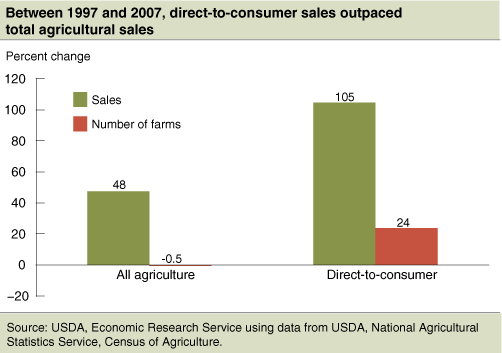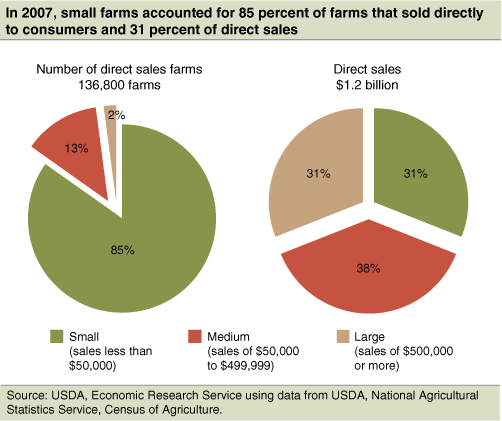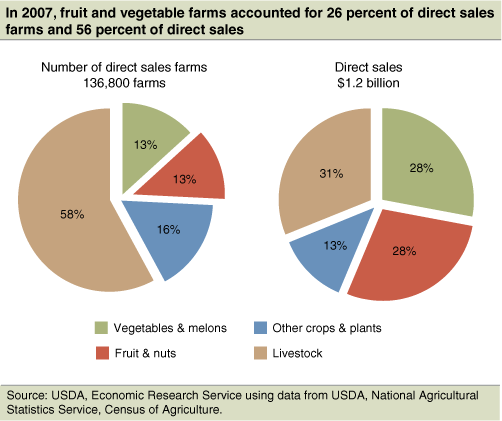Varied Interests Drive Growing Popularity of Local Foods
- by Stephen Martinez
- 12/1/2010
Highlights
- Local foods are a growing but small component of U.S. agriculture.
- Local foods typically refers to foods produced near their point of consumption, but there is no consensus as to what distances constitute local.
- Other characteristics are also used to define local foods, including production methods, types of producers, and whether the foods are sold directly to consumers or to food distributors.
In the early 1900s, nearly 40 percent of Americans lived on farms, and most food was locally grown and marketed. Food processing amounted to canning, dehydrating, salting, or smoking, and few foods traveled more than a day to market. Consumption was dictated by local seasonality. Following World War II, transportation costs dropped and improvements in refrigeration allowed perishable items such as meats and produce to be shipped across the globe affordably.
In the late 1960s, a desire to eat locally was aligned with a budding environmental movement. A more recent renewal of that aspiration has gained momentum. As interest and demand for local foods grow, so do questions about what constitutes “local” foods, what characterizes local food markets, and what the impact of local food is on economic development, health, and environmental quality.
Local Food Is Defined by Travel Distance, Although Distances Vary
“Local foods” is often thought of as a geographic concept, referring to the distance from production to consumption. The New Oxford American Dictionary defines its 2007 word of the year, “locavore,” as a person who tries to eat only food grown or produced within a 100-mile radius. However, there is little consensus that 100 miles equates to local.
Several food retail companies have adopted their own local food definitions. Wal-Mart, for example, defines local food as that produced within a State’s borders. Dorothy Lane Market—a small independent supermarket with three gourmet stores in Dayton, OH—considers foods grown or raised within a 250-mile radius of Dayton as local. According to Whole Foods, a “natural” and organic food retailer, products must travel less than a day (7 or fewer hours by car or truck) from farm to store to be designated as local. However, most Whole Foods’ stores have established even shorter maximum distances.
Federal and some State policymakers also have their own definitions. According to the definition adopted by the U.S. Congress in the 2008 Food, Conservation, and Energy Act, “locally or regionally produced agricultural food product” can only travel less than 400 miles from its origin, or within the State in which it is produced. Vermont law requires that “local” items originate within 30 miles of the point of sale.
Distances perceived to constitute local may also vary by region. Population density is important because what is considered local in a sparsely populated area may be quite different in more heavily populated regions. For example, people accustomed to driving great distances for specialized services or goods may regard a day’s drive as local, whereas the same distance is unlikely to be regarded as “local” by a resident of a large city.
Local food definitions may even vary within the same region. In 2009, four farmers’ markets located in central Virginia defined “local” as goods grown or produced within a 100-mile radius and in Virginia. Two other central Virginia farmers’ markets required food to be grown within a 75-mile radius, and one required food to be grown within the county.
What Do Consumers Look for in Local Foods?
In addition to geographic proximity, consumers ascribe other characteristics to local foods. Consumers in a national study by the Food Marketing Institute in 2009 cited freshness (82 percent), support for the local economy (75 percent), and knowing the source of the product (58 percent) as reasons for buying local food. Important features of local food marketing channels are that production and distribution occur in a specific region, and consumers are informed about the local nature of products, for example, through personal communication.
Several studies have identified consumer perceptions of local food, including that local produce is fresher looking and tasting, of higher quality, and a better value for the price. Some consumers associate local foods with environmentally sustainable production methods, such as limited use of chemicals, energy-based fertilizers, and pesticides. Consumers also may extend local food production methods to include fair farm labor practices and animal welfare. In some consumers’ minds, local foods are synonymous with small farms that are committed to the local community through social and economic relationships.
Surveys to elicit consumer attitudes about local foods suggest that consumers may be willing to pay a premium for in-State products, from 9 percent for a specialty food product in New England (maple syrup, salsa, cookies, etc.) and Colorado potatoes, to 50 percent for fresh Florida-grown produce. Consumers with higher willingness to pay a premium for local food also tend to place greater importance on quality, nutrition, the environment, and helping farmers in their State.
Some Local Foods Are Marketed Directly to Consumers…
The varying definitions of local foods make it difficult to define precisely the size and scope of the sector. To quantify the development of the local foods market, ERS researchers used census of agriculture data and data from the research firm Packaged Facts.
Direct-to-consumer marketing of local foods includes sales at farmers’ markets, farm stands/onfarm sales, pick-your-own operations, and community-supported agriculture (CSAs) operations. With CSAs, local residents purchase shares in a farmer’s expected harvest before planting, then receive weekly deliveries or pick up from the farm throughout the growing season. However, census figures on direct sales to consumers are not equivalent to the value of local direct-to-consumer marketing. For example, catalog and Internet sales are included in census’s direct sales to consumers, but such customers are typically not local. On the other hand, local food systems include community gardening, which does not involve commercial farming and so is not included in census data.
According to census data, direct sales to consumers account for a small but growing segment of U.S. agriculture. Direct sales of agricultural products, including Internet and catalog sales, totaled $1.2 billion in 2007, or 0.4 percent of total agricultural sales. From 1997 to 2007, direct sales increased by 105 percent ($619 million), compared with an increase of 48 percent for all agricultural sales ($95.8 billion).
Over the same period, the number of farms selling directly to consumers increased by 24 percent, compared with a 0.5-percent reduction in the total number of farms. In 2007, the 136,800 farms selling directly to consumers surpassed the number performing custom work (services for others such as planting, plowing, spraying, and harvesting), agritourism, and sales of firewood and other forest products, positioning direct sales as the leading onfarm supplemental enterprise.
Farmers’ markets and CSA operations also have grown considerably. Based on USDA surveys, the number of U.S. farmers’ markets rose threefold from 1,755 in 1994 to 6,132 in 2010. In 2005, there were 1,144 CSAs, up from 761 in 2001 and 2 in 1986. An online registry maintained by LocalHarvest indicates that there now are over 2,500 CSAs in the United States.
…and to Retailers, Restaurants, and Institutions
Farmers also sell their products to local restaurants, retail stores, and institutions such as government entities, hospitals, and schools (direct-to-retail/foodservice). These products may reach the retail or foodservice establishment directly from the farmer or move through one or more intermediaries, such as a wholesaler. Based on data from Packaged Facts and the census of agriculture, direct-to-retail/foodservice sales amounted to $3.8 billion in 2007, up 19 percent from $3.2 billion in 2002. Small, independent grocery retailers, whose identity and stocking practices are closely linked to specific geographic locations, may be better positioned to incorporate local foods as part of their corporate identity. For example, Dorothy Lane Market began as a fruit stand in 1948. It has since developed a strong relationship with area farmers and now carries a variety of local products from surrounding farms.
Larger food retail chains are also seeking to capitalize on the growing popularity of local foods. Several leading retailers—including Wal-Mart, Safeway, Meijer, and Weis Markets—have recently announced local food initiatives. In 2009, 7 of the top 10 food retailers had some reference to local foods on their websites.
Surveys conducted by the National Restaurant Association (NRA) suggest increasing interest in local foods by restaurants and their patrons. According to NRA’s 2008 operator survey, 89 percent of fine-dining operators served locally sourced items and 90 percent believed it would become more popular. Nearly 30 percent of fast food operators served locally sourced items in 2008, and nearly half believed these items would grow more popular. In 2008, Chipotle Mexican Grill, one of the fastest growing fast food chains, began purchasing 25 percent of at least one produce item for each of its stores from farms located within 200 miles of the retail store.
Farm-to-school programs represent an important component of the institutional market for locally grown produce. For most of these programs, school food authorities buy fresh produce directly from local farmers for some or all of their produce needs. In other programs, schools sponsor school garden projects or field trips to nearby farms as part of an expanded nutrition education curriculum. The overall goals of the programs are to provide children with access to fresh fruit and vegetables and promote relationships between schools and farms that can strengthen over time. The National Farm to School Network estimated that there were 2,051 farm-to-school programs in the United States in 2009, up from only 2 in 1996-97, and twice as many as in 2005-06.
Direct-to-Consumer Sales Are Especially Important for Small Produce Farms
The 2007 Census of Agriculture provides information on the characteristics of farms engaged in direct sales to consumers. The census data show that access to urban markets is crucial to farms engaged in direct sales. Counties with the highest levels of direct sales are concentrated in the urban corridors of the Northeast and the West Coast.
Direct sales farms located in or adjacent to metro counties accounted for 84 percent of all farms engaged in direct sales, and earned 89 percent of all direct sales income. Direct sales per farm decreased for farms located progressively farther from metropolitan counties, averaging $10,987 for farms located in metro counties, $6,767 for farms in rural counties adjacent to metro counties, and $6,090 for farms in remote rural counties.
According to the census of agriculture, total direct-to-consumer sales in 2007 were roughly evenly split between small (less than $50,000 in total farm sales), medium (sales of $50,000 to $499,999), and large farms (sales of $500,000 or more), even though small farms accounted for 85 percent of the number of direct-sales farms. Direct sales accounted for over 35 percent of total farm sales on average for small farms, providing an important sales outlet for their farm output. In contrast, direct sales accounted for an average of 17 percent of medium-sized farms’ total sales and only 7.5 percent of large farms’ total sales.
Bundling other processing or farm-related enterprises with direct sales appears to be especially important for small farms. Small farms constituted 77 percent of all farms combining direct sales with other activities, such as production of value-added products (such as beef jerky, fruit jams, jelly, preserves, or cutting and arranging flowers), agritourism, alternative energy production, sales of forest products, and organic production.
There were fewer fruit and vegetable producers engaged in direct sales to consumers than there were livestock and other crop producers, but a larger percentage of fruit and vegetable producers sold directly to consumers. In addition, they earned two to three times more in direct sales per farm than livestock and other crop producers. Consequently, fruit and vegetable producers accounted for a disproportionately larger percentage of all direct sales. Among livestock farms, beef cattle operations accounted for 54 percent of farms selling directly to consumers and 47 percent of direct sales.
Vegetables and fruit need little processing and, therefore, are most readily available for market through farmers’ markets, roadside stands, and pick-your-own operations. According to USDA’s 2006 National Farmers’ Market Survey, the most popular product category sold at farmers’ markets was fresh fruit and vegetables, which was sold by nearly 92 percent of farmers’ market managers in 2005, followed by herbs and flowers; honey, nuts, and preserves; and baked goods.
Public Policies and Programs Support Local Food Systems
Numerous public programs and policies support local food initiatives, and the number of programs is growing. Some Federal programs provide financing that directly supports local food systems. For example, the Federal State Marketing Improvement Program provides matching funds to State agencies to assist in exploring new market opportunities for food and agricultural products. In 2009, 8 out of 23 grants awarded went to projects supporting local foods, such as funding to improve the effectiveness of Colorado MarketMaker. A national partnership of land grant institutions and State departments of agriculture currently active in 15 States and the District of Columbia, MarketMaker provides an interactive mapping system to match retailers, wholesalers, processors, and other buyers with farmers, farmers’ markets, and other sources of agricultural products.
Federal programs also provide support by encouraging purchases at local food outlets. The Senior Farmers’ Market Nutrition Program provides low-income seniors with coupons that can be used to purchase fresh fruit and vegetables at authorized farmers’ markets, roadside stands, and CSA programs. Farmers or authorized outlets then submit coupons for payment by the State agency that operates the program. In fiscal year 2009, 809,711 seniors received these coupons and 18,714 farmers participated in the program at 3,684 farmers’ markets, 3,061 roadside stands, and 159 CSAs.
Local foods remain a small portion of U.S. agriculture. But as interest in local food systems has increased, so has the desire to understand how local food markets affect farmers, consumers, and communities (see box, “Studies Examine Economic and Environmental Impacts of Local Food Markets”). Understanding these impacts can result in more cost-effective programs that support local foods within the broader U.S. food marketing system.
This article is drawn from:
- Martinez, S., Hand, M.S., Da Pra, M., Pollack, S., Ralston, K., Smith, T., Vogel, S., Suttles, S., Lohr, L., Low, S.A. & Newman, C. (2010). Local Food Systems: Concepts, Impacts, and Issues. U.S. Department of Agriculture, Economic Research Service. ERR-97.
You may also like:
- King, R.P., Hand, M.S., DiGiacomo, G., Clancy, K., Gómez, M.I., Hardesty, S.D., Lev, L. & McLaughlin, E.W. (2010). Comparing the Structure, Size, and Performance of Local and Mainstream Food Supply Chains. U.S. Department of Agriculture, Economic Research Service. ERR-99.
- Just What Does Local Mean?. (2010). Choices. Vol. 25, No. 1.




